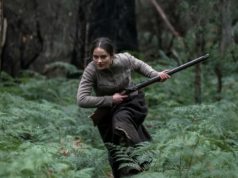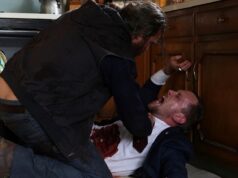With this colossal disaster, Ben Wheatley proves again that he is a terrible director who has gotten a lot more attention than he deserved
High-Rise (2015)
Directed by Ben Wheatley. Written by Amy Jump. Starring Tom Hiddleston, Jeremy Irons, Sienna Miller, Luke Evans, Elisabeth Moss, James Purefoy, Keeley Hawes, Augustus Prew and Peter Ferdinando.
Oh, Ben Wheatley. I don’t know why I insist in the hopes that you will come up with anything good. Some might say I don’t get you but, honestly, I couldn’t stand a second of Sightseers (2012) and Kill List (2011), both praised by critics. But now, after this disastrous shot at adapting J. G. Ballard’s novel of the same name, I fail to see how anyone will be able to defend you.
For a long time deemed “unfilmable” since producer Jeremy Thomas decided to make it into a film in 1975, Ballard’s novel has been a passion project envisioned for Nicolas Roeg (Don’t Look Now) to direct it from a script by Paul Mayersberg. Thirty years later, the idea was to have Vincenzo Natali (Cube) make a loose adaptation written by Richard Stanley. I don’t know what went wrong, but finally — and God knows why — it ended up in Wheatley’s hands, and the fact that High-Rise turned out to be such a colossal disaster is no surprise to me. It only makes me sigh in silent resentment. Oh, I never learn.
Adapted by none other than Amy Jump — Wheatley’s wife who was also responsible for those two aforementioned works — High-Rise follows Dr. Robert Laing (Tom Hiddleston) as he recollects from a ravaged forty-story tower block the last three months that led him to that point after he moved into an apartment on the 25th floor following the death of his sister. The cutting-edge tower was built by renowned architect Anthony Royal (Jeremy Irons) as a true microcosm of the capitalist system: the richest ones living in the upper floors and the ones with less economic power occupying the lower floors. The building provides everything and all conveniences including a supermarket, gym, spa, swimming pools and a school.
Once there, Laing meets fellow tenants Charlotte Melville (Sienna Miller), a single mother living with her son, and Richard Wilder (Luke Evans), a documentary filmmaker who lives in a low-level apartment with his pregnant wife Helen (Elisabeth Moss). Many other people appear as Laing attends parties thrown by the residents, including Royal’s wife Ann (Keeley Hawes). But it doesn’t matter, really. It is even pointless to discuss what he does and his relationship with the other tenants, when everything that happens and everyone he meets seems completely arbitrary from the get-go. Things occur as if in a dream, and we are left with a strong impression that it is all supposed to be, in fact, more of a visual experience than anything else.
To be honest, after the film ended, I took a look at the detailed plot summary to make sure I hadn’t missed anything, and it wasn’t my fault that everything looked so awfully messy and confusing. It was not my fault, though. Wheatley directs High-Rise more like a flashy art film, or an object. The high-rise looks futuristic with its stratified floors when seen from the outside but contrasted with old cars that are obviously from the 1970s. Ann’s fancy party is an 18th-century post-retro-rococo costume party to the sound of ABBA’s SOS as performed by Clint Mansell and his violins. A lot of attention is given especially to the production design, like the stylish elevators and Royal’s garden that seems like out of a fairy tale.
Wheatley must think of himself as a real artist, shattering a glass of wine on the hood of a car in slow motion before doing the same with a man’s body. When he places a reddish sun behind the high-rise with dissonant music, he makes it seem like the devil’s tower. But it is all very obvious, with no recognizable visual style or personality — much like the film’s lack of structure and direction. At some point, I wondered in disbelief if I was really witnessing all that or if I was hallucinating. There is a moment when a character physically attacks another one saying that not even the Geneva Convention could save him (and if that was supposed to be funny, I cannot say). I feared he was referring to me.
But if I mention the disjointed structure of High-Rise, what is there to say about a huge gallery of characters who too are more like devices than real people? Tom Hiddleston may be talented and gorgeous with his perfect cheekbones and hands (“an excellent specimen,” as Charlotte points out), but he can’t do much with a one-dimensional character who loses his mind for some inscrutable reason. When he cries to the sound of Portishead’s rendition of SOS, I have absolutely no idea why he does so. And all the madness that takes place in the high-rise cannot justify most of his random decisions or why he would refer to himself in the third person when narrating his story to us. He is just an empty shell and nothing else.
Much like all of the other characters. About them, we have only glimpses that don’t amount to much; moments conceived as satirical bits. Wheatley wants to mock the ridiculous decadence of that society by showing the failing infrastructure, the rotten fruits in the supermarket and how no police appear after someone’s suicide. But the satire is childish and silly. Like when we see Helen with a huge pregnant belly smoking a cigarette and watching a soap opera on TV, or the fact that Wilder is a hateful lunatic who tortures women. Is he supposed to be a revolutionary? “Possibly the sanest man in the building,” Laing says. I beg to differ.
Most of what we see looks just terribly heavy-handed as far as satire goes. A picture of Che Guevara on a wall is obvious in its implications. We see the high-society snobs dancing like crazies to Johann Sebastian Bach while Laing is having sex with his face covered in paint. Artsy, I suppose. Not to mention a bizarre scene of murder seen through a kaleidoscope. All filmed with a self-importance present even in Mansell’s operatic score.
But it doesn’t matter how clever Wheatley thinks his film is (it definitely isn’t) or how visually spellbinding he thinks it all looks (again, it doesn’t). The fact is that he only proves to me once again what I have been saying since his two other films: that he is just a terrible director who has gotten a lot more attention than he deserves. But like I said, I never learn.





